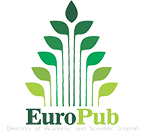An overview to photo-catalytic degradation of dyes in waste water
Vol 2, Issue 2, 2019
VIEWS - 6604 (Abstract)
Abstract
Organic dyes used in textile and food industries are the important sources of environmental contaminations due to their non-bio degradability and high toxicity to aquatic creatures and carcinogenic effects on humans. This demands environmental remediation by the use of techniques which are environmentally benign. For this purpose, a general overview of dye degradation by light in the presence of materials as photo-catalysts has been given. The mechanism of action has also been described. Importantly, the materials involved in dye degradation usually involve nano-composites of either conducting polymers or metal-oxidesor graphene based systems which are insoluble in aqueous solutions, hence will be environmentally benign and can therefore be recovered after use.
Full Text:
PDFReferences
- Pan Xiong,Lianjun Wang, Xiaoqiang Sun,Binhai, Xuand Xin Wang, Ternary Titania−Cobalt Ferrite−Polyaniline Nanocomposite: A Magnetically Recyclable Hybrid for Adsorption andPhotodegradation of Dyes under Visible Light, Ind. Eng. Chem. Res. 2013, 52, 10105−10113
- Chen C., Lu C., Chung Y,Photocatalytic degradation of ethyl violet in aqueous solution mediated by TiO2 suspensions,J. Photochem.Photobiol., A: Chem. 2006, 181, 120−125.
- Oliveira A. S., Saggioro E. M., Barbosa N. R., Mazzei A., Ferreira L. F. V., Moreira J. C., Surfacephotocatalysis: A study of the thickness of TiO2 layers on the photocatalytic decomposition of soluble indigo blue dye, Rev. Chim. (Bucharest, Rom.)2011, 62, 462−468.
- Sojić D.,Despotović V.,Abramović B., Todorova N.,Giannakopoulou T., Trapalis C., Photocatalytic degradation of mecoprop and clopyralid in aqueous suspensions of nanostructured N-doped TiO2, Molecules 2010, 15, 2994−3009.
- Vasapollo G., Mele G., Sole R. D.,Pio I., Li J., Mazzetto S. E.,Use of novel cardanol-porphyrin hybrids and their TiO2-based composites for the photodegradation of 4-nitrophenol in water, Molecules 2011, 16, 5769−5784.
- M. HasmathFarzana and SankaranMeenakshi, Synergistic Effect of Chitosan and Titanium Dioxide on the Removal of Toxic Dyes by the Photodegradation Technique, Ind. Eng. Chem. Res. 2014, 53, 55−63
- Kun Liang, Beng Kang Tay,Olga V. Kupreeva, Taisiya I. Orekhovskaya, Sergei K. Lazarouk,and Victor E. Borisenko, Fabrication of Double-Walled Titania Nanotubes and Their Photocatalytic Activity, ACS Sustainable Chem. Eng. 2014, 2, 991−995.
- Haimei Fan, Haiyan Li, Bingkun Liu, Yongchun Lu, TengfengXie and Dejun Wang,Photoinduced Charge Transfer Properties and Photocatalytic Activity in Bi2O3/BaTiO3 Composite Photocatalyst, ACS Appl. Mater. Interfaces 2012, 4, 4853−4857.
- FengyuShen, WenxiuQue, Yucheng He,Yuan Yuan, Xingtian Yin and Gangfeng Wang, Enhanced Photocatalytic Activity of ZnO Microspheres via Hybridization with CuInSe2 and CuInS2Nanocrystals, ACS Appl. Mater. Interfaces 2012, 4, 4087−4092.
- Mohd. Hanief Najar and Kowsar Majid, Enhanced photocatalytic activity exhibited by PTh/ [Fe(CN)3(NO)(bpy)]4H2O nanocomposite fibers viaa synergistic approach, RSC Adv. 2015, 5, 107209–107221.
DOI: https://doi.org/10.24294/ace.v1i4.615
Refbacks
- There are currently no refbacks.

This work is licensed under a Creative Commons Attribution-NonCommercial 4.0 International License.









